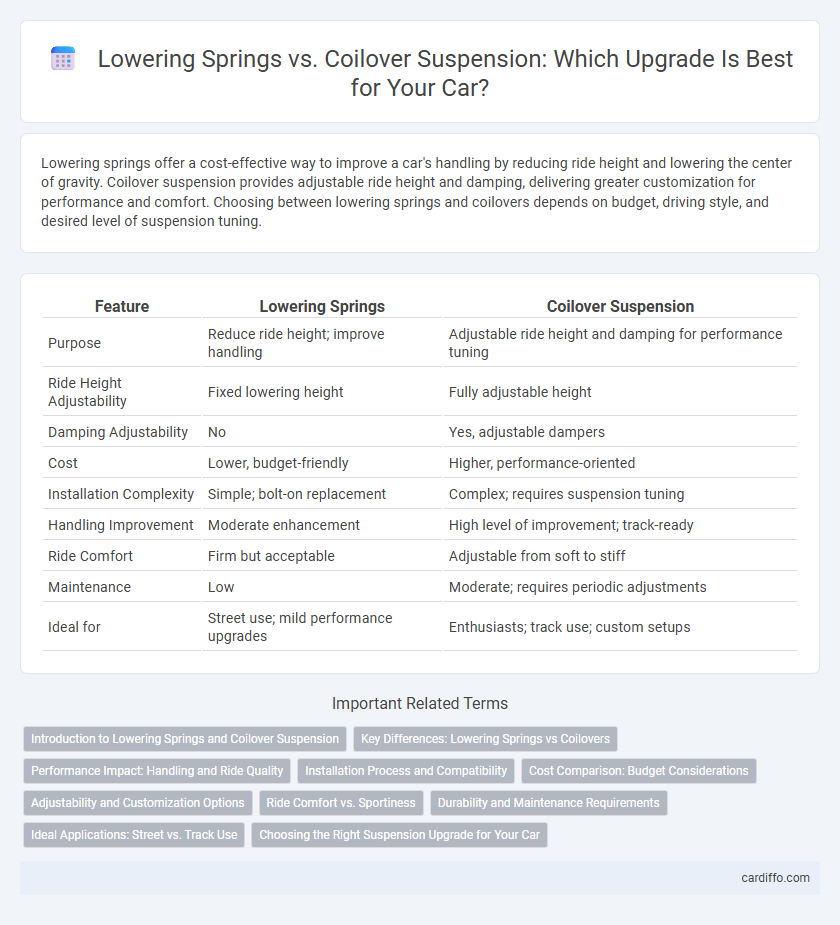Lowering springs offer a cost-effective way to improve a car's handling by reducing ride height and lowering the center of gravity. Coilover suspension provides adjustable ride height and damping, delivering greater customization for performance and comfort. Choosing between lowering springs and coilovers depends on budget, driving style, and desired level of suspension tuning.
Table of Comparison
| Feature | Lowering Springs | Coilover Suspension |
|---|---|---|
| Purpose | Reduce ride height; improve handling | Adjustable ride height and damping for performance tuning |
| Ride Height Adjustability | Fixed lowering height | Fully adjustable height |
| Damping Adjustability | No | Yes, adjustable dampers |
| Cost | Lower, budget-friendly | Higher, performance-oriented |
| Installation Complexity | Simple; bolt-on replacement | Complex; requires suspension tuning |
| Handling Improvement | Moderate enhancement | High level of improvement; track-ready |
| Ride Comfort | Firm but acceptable | Adjustable from soft to stiff |
| Maintenance | Low | Moderate; requires periodic adjustments |
| Ideal for | Street use; mild performance upgrades | Enthusiasts; track use; custom setups |
Introduction to Lowering Springs and Coilover Suspension
Lowering springs are designed to reduce a vehicle's ride height by replacing the factory springs, offering improved handling and a sportier appearance without significant changes to the stock suspension setup. Coilover suspension combines springs and shock absorbers into a single, adjustable unit, providing customizable ride height, damping, and enhanced performance for precise handling. Both options serve the purpose of lowering a vehicle but differ in adjustability, cost, and complexity, catering to various driving preferences and performance goals.
Key Differences: Lowering Springs vs Coilovers
Lowering springs reduce ride height by replacing just the springs, offering a budget-friendly option with a fixed drop and improved handling but limited adjustability. Coilover suspension combines springs and shocks into a single, adjustable unit, allowing precise control over ride height, damping, and stiffness for performance customization. Key differences include coilovers' versatility and higher cost versus lowering springs' simplicity and affordability.
Performance Impact: Handling and Ride Quality
Lowering springs improve handling by reducing body roll and lowering the center of gravity, resulting in enhanced cornering stability, but they offer a firmer ride that can compromise comfort on rough roads. Coilover suspension provides adjustable ride height and damping settings, allowing for precise tuning of handling characteristics and ride quality to suit different driving conditions and preferences. Performance-minded drivers benefit from coilovers' versatility, while lowering springs offer a simpler, less expensive upgrade with noticeable handling improvements.
Installation Process and Compatibility
Lowering springs offer a simpler installation process, typically requiring standard tools and fewer modifications, making them compatible with most factory suspension setups. Coilover suspension systems demand precise adjustments during installation, often necessitating specialized tools and expertise to ensure proper fitment and optimal performance. Compatibility varies as lowering springs are designed for specific vehicle models, while coilovers provide adjustable ride height and damping, allowing broader adaptability across different vehicles.
Cost Comparison: Budget Considerations
Lowering springs typically cost between $200 and $500, making them a more budget-friendly option for car enthusiasts aiming to improve handling and aesthetics without extensive modifications. Coilover suspension systems range from $1,000 to $3,500 or more, reflecting their advanced adjustability and performance benefits but requiring a higher initial investment. When prioritizing cost, lowering springs offer an affordable upgrade with moderate performance gains, while coilovers provide superior customization at a premium price point.
Adjustability and Customization Options
Lowering springs provide a fixed drop height and limited damping adjustments, making them a cost-effective choice for basic suspension upgrades. Coilover suspension systems offer extensive adjustability, including ride height, damping stiffness, and camber settings, allowing for precise customization tailored to driving conditions and preferences. Enthusiasts seeking optimal performance and versatility typically prefer coilovers for their superior tuning capabilities.
Ride Comfort vs. Sportiness
Lowering springs enhance sportiness by reducing ride height and improving handling but can compromise ride comfort due to stiffer spring rates. Coilover suspension systems offer customizable damping and height adjustments, allowing a balance between aggressive handling and ride comfort suited to individual preferences. Choosing between the two depends on prioritizing daily drivability or track performance.
Durability and Maintenance Requirements
Lowering springs typically offer greater durability due to their simpler design and fewer moving components, resulting in lower maintenance requirements compared to coilover suspensions. Coilovers, with adjustable features and more intricate parts, demand more frequent inspections and upkeep to ensure optimal performance and prevent premature wear. Choosing between lowering springs and coilover suspension depends on balancing desired ride customization against maintenance commitment and long-term durability.
Ideal Applications: Street vs. Track Use
Lowering springs provide a cost-effective solution for street use, improving handling and aesthetics without significantly compromising ride comfort, making them ideal for daily driving and casual spirited rides. Coilover suspension offers adjustable ride height and damping, optimized for track applications where precise handling and performance tuning are critical. Drivers seeking enhanced cornering capabilities and track adaptability typically prefer coilovers, while those prioritizing everyday usability find lowering springs more suitable.
Choosing the Right Suspension Upgrade for Your Car
Choosing the right suspension upgrade involves evaluating lowerings springs and coilover suspensions based on performance goals, budget, and ride quality preferences. Lowering springs provide a cost-effective solution for improved handling and a modest drop in ride height, while coilovers offer adjustable ride height and damping, delivering customizable performance for track or street use. Understanding vehicle weight, spring rates, and desired suspension travel is crucial to selecting the optimal upgrade that enhances both handling dynamics and driving comfort.
Lowering Springs vs Coilover Suspension Infographic

 cardiffo.com
cardiffo.com